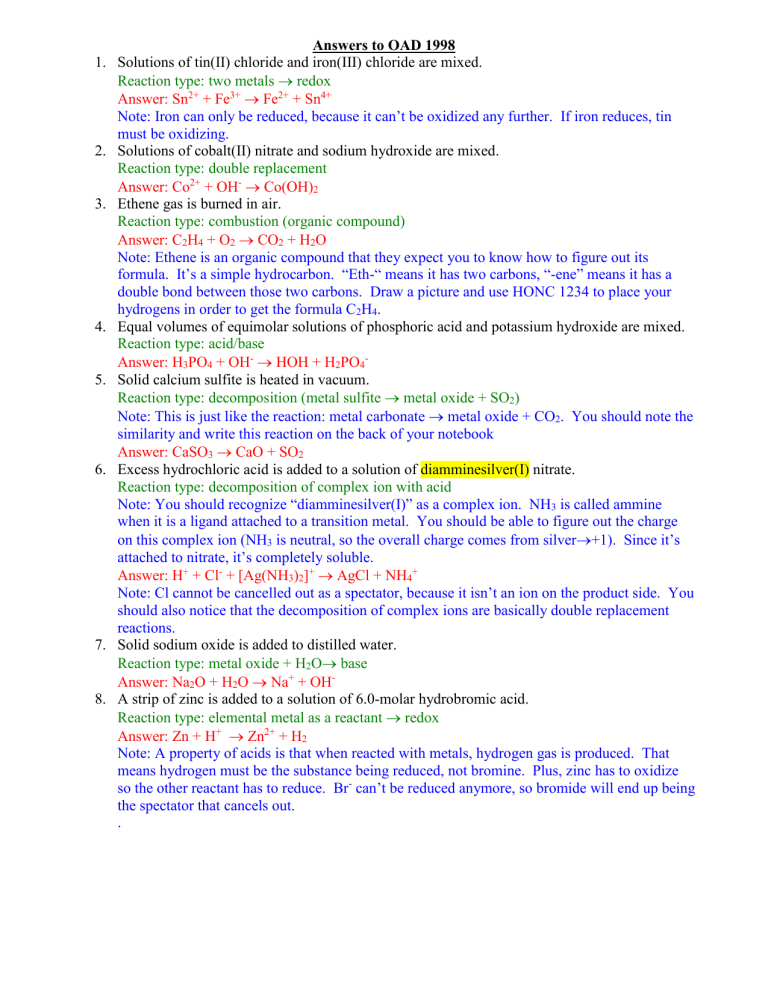
1.
2.
3.
4.
5.
6.
7.
8.
Answers to OAD 1998
Solutions of tin(II) chloride and iron(III) chloride are mixed.
Reaction type: two metals redox
Answer: Sn2+ + Fe3+ Fe2+ + Sn4+
Note: Iron can only be reduced, because it can’t be oxidized any further. If iron reduces, tin
must be oxidizing.
Solutions of cobalt(II) nitrate and sodium hydroxide are mixed.
Reaction type: double replacement
Answer: Co2+ + OH- Co(OH)2
Ethene gas is burned in air.
Reaction type: combustion (organic compound)
Answer: C2H4 + O2 CO2 + H2O
Note: Ethene is an organic compound that they expect you to know how to figure out its
formula. It’s a simple hydrocarbon. “Eth-“ means it has two carbons, “-ene” means it has a
double bond between those two carbons. Draw a picture and use HONC 1234 to place your
hydrogens in order to get the formula C2H4.
Equal volumes of equimolar solutions of phosphoric acid and potassium hydroxide are mixed.
Reaction type: acid/base
Answer: H3PO4 + OH- HOH + H2PO4Solid calcium sulfite is heated in vacuum.
Reaction type: decomposition (metal sulfite metal oxide + SO2)
Note: This is just like the reaction: metal carbonate metal oxide + CO2. You should note the
similarity and write this reaction on the back of your notebook
Answer: CaSO3 CaO + SO2
Excess hydrochloric acid is added to a solution of diamminesilver(I) nitrate.
Reaction type: decomposition of complex ion with acid
Note: You should recognize “diamminesilver(I)” as a complex ion. NH3 is called ammine
when it is a ligand attached to a transition metal. You should be able to figure out the charge
on this complex ion (NH3 is neutral, so the overall charge comes from silver+1). Since it’s
attached to nitrate, it’s completely soluble.
Answer: H+ + Cl- + [Ag(NH3)2]+ AgCl + NH4+
Note: Cl cannot be cancelled out as a spectator, because it isn’t an ion on the product side. You
should also notice that the decomposition of complex ions are basically double replacement
reactions.
Solid sodium oxide is added to distilled water.
Reaction type: metal oxide + H2O base
Answer: Na2O + H2O Na+ + OHA strip of zinc is added to a solution of 6.0-molar hydrobromic acid.
Reaction type: elemental metal as a reactant redox
Answer: Zn + H+ Zn2+ + H2
Note: A property of acids is that when reacted with metals, hydrogen gas is produced. That
means hydrogen must be the substance being reduced, not bromine. Plus, zinc has to oxidize
so the other reactant has to reduce. Br- can’t be reduced anymore, so bromide will end up being
the spectator that cancels out.
.
